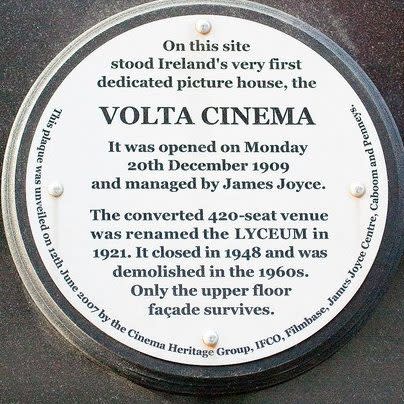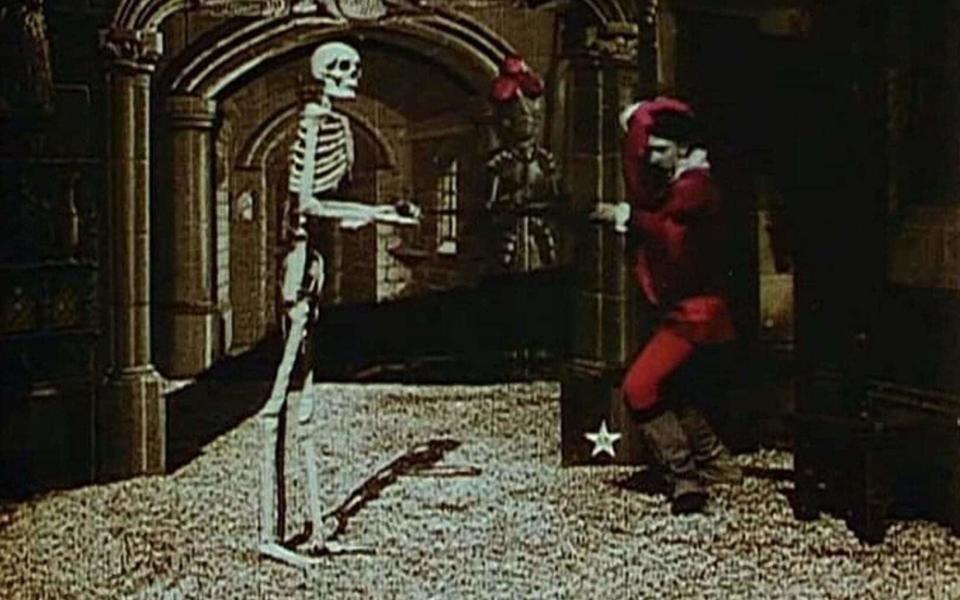At the movies with James Joyce – and his crabs

- Oops!Something went wrong.Please try again later.
- Oops!Something went wrong.Please try again later.
1922 saw the publication of Ulysses in February – 100 years ago to this day – and The Waste Land in October. These two texts are among the greatest achievements in prose and poetry of the modernist movement, and some crabbier critics might argue that it’s been largely downhill since then.
It was also a remarkable year for the well-established medium of cinema. June saw the US première of Robert Flaherty’s seminal Nanook of the North, the first commercially successful feature-length documentary and, in November, the first two-tone technicolor movie The Toll of the Sea was released.
Along with the usual potboilers, westerns and one-reel comedies there were screen adaptations of The Beautiful and Damned, Robinson Crusoe, Macbeth, The Count of Monte Cristo, Oliver Twist and Vanity Fair.
These and other adaptations reflected a tendency for film producers to seek a degree of social and cultural respectability through prestigious association, and to attract profitable “high hat” audiences—metropolitan, sophisticated and with more “advanced” tastes. Further down the bill were crowd-pleasing shorts by Chaplin and Keaton, and a spoof of that year’s Rudolph Valentino hit entitled Mud and Sand starring Stan Laurel (still a solo act) as “Rhubarbo Vaselino”.
James Joyce’s professional connection with cinema is well known. Prompted by his sister Eva’s observation that there were 21 cinemas in Trieste but none at all in Dublin, Joyce secured the backing of a group of Triestine businessmen who had already opened cinemas in Hungary and Italy and now had plans for new picture houses in Dublin, Belfast and Cork. He travelled back to Dublin in 1909 to set up the Cinematograph Volta, a 420-seat venue at 45, Mary Street. Ireland’s first dedicated cinema, it’s long-since demolished but there’s a plaque attached to Penney’s, the modern department store that now occupies the site.

The Volta opened for business on the afternoon of Monday 20th December 1909, and the event was reported the following day in The Freeman’s Journal:
“Yesterday at 45 Mary street a most interesting cinematograph exhibition was opened before a large number of invited visitors. [...] An excellent little string orchestra played charmingly during the afternoon. Mr. James Joyce, who is in charge of the exhibition, has worked apparently indefatigably in its production, and deserves to be congratulated on the success of the inaugural exhibition.”
Not mentioned in the newspaper report are two films screened that day: Bewitched Castle (likely to be a short by George Méliès better known as Haunted Castle, dating back to 1897) and Deviled Crab, an Italian comedy short made in 1909 and originally entitled Cretinetti ha ingoiato un gambero (literally “Cretinetti has swallowed a prawn”), released under the English title Foolshead Swallows a Crab before it appeared at the Volta under its new title. It’s unclear at what point the film was renamed—could Joyce himself have had a hand in it?
The original English title offers a coincidental link to the moment in the “Lestrygonians” episode of Ulysses when Bloom mulls over what to have for lunch in Davy Byrne’s pub:
“Like a few olives too if they had them. Italian I prefer. Good glass of burgundy take away that. Lubricate. A nice salad, cool as a cucumber, Tom Kernan can dress. Puts gusto into it. Pure olive oil. Milly served me that cutlet with a sprig of parsley. Take one Spanish onion. God made food, the devil the cooks. Devilled crab.”
Crabs, having neither fins nor scales, aren’t kosher, although Mr Bloom, an unobservant Jew who has breakfasted on pork kidneys, would not be put off by that. Is this conceivably a cryptic reference by Joyce to the programme at the Volta? Get weaving, Joyceans.

A digression. While researching the Volta opening programme I came across a silent comedy called Deviled Crabs dating from 1917, one of 78 “electrically convulsing fun shorts” produced and distributed between 1916 and 1918 by the Jaxon Film Corporation of Jacksonville, Florida. While Deviled Crabs is obviously not among the films screened at the opening night of the Volta in 1909, I include the following synopsis from Moving Picture World (6th October, 1917), for reasons that will be immediately apparent to readers of Finnegans Wake:
“Pokes, a hod-carrier, has been discharged by Jabs, the contractor, and on his way home he stops at the saloon to drown his sorrows and partakes freely of devilled crabs and beer. When he arrives home his wife seats him before the fire to rest while she prepares supper. Strange sights appear to Pokes. The devil, with Jabs’ face, comes out of the fireplace and Pokes signs a bond selling himself to Satan for a rousing good time. His clothes immediately change and money rains on him. Pokes has a great time, but the devil is always at his elbow. Finally, he decides to rid himself of Satan or Jabs, whichever it is, and hides under the haystack, but it immediately catches fire and Pokes wakes with a wild cry to find that he has poked his feet into the blazing fire. His wife puts out the flames and says, ‘Come to supper, we have nice deviled crabs.’ Pokes’ reply is left to the imagination, but there are a lot of broken dishes in the yard the next morning.”
Is it remotely conceivable that the drunken hod carrier Pokes is a distant cousin to “this man of hod, cement and edifices” Tim Finnegan? Is it also possible that Joyce had Pokes and Jabs in mind when he came to create the duos of Mutt and Jute or Glugg and Chuff in Finnegans Wake?
The Volta was not a commercial success—many of the films screened were Italian or French productions which came complete with Italian intertitles, so a synopsis in English had to be printed and handed out to audiences. This, mark you, in a city where the tram routes had symbols for the benefit of the illiterate. It must have been a dispiriting experience, straining in the gloom to decipher the crib sheet. The programme ran on an hourly cycle between 5pm and 10pm. Dubliners stayed away in droves and Joyce returned to Trieste to face his backers.
The Volta was subsequently sold to the British Provincial Cinema Company and struggled on, finally closing in 1919. It re-opened after the war as the Lyceum Picture Theatre, but was never particularly successful and the curtain came down for the last time in 1948.
Multiple Joyce by David Collard is published by Sagging Meniscus in June

